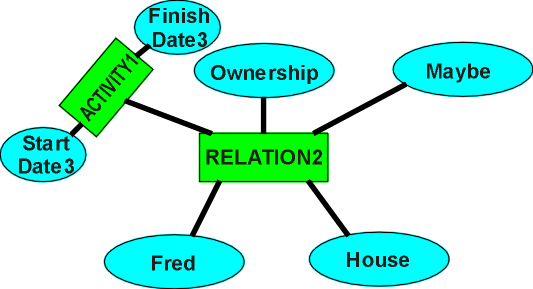 The operator links control and existence to a relation between its
parameters. Each of the connections can function as an input or an output, allowing the
operator to display a wide range of behaviour.
The operator links control and existence to a relation between its
parameters. Each of the connections can function as an input or an output, allowing the
operator to display a wide range of behaviour.The format of the RELATION2 operator is:
Control@ EQV RELATION2(RelationInvocation, TimeControl@, Object1, Object2)
(the operator is usually built by a user tool other than the Editor, such as an NLP Parser)
 The operator links control and existence to a relation between its
parameters. Each of the connections can function as an input or an output, allowing the
operator to display a wide range of behaviour.
The operator links control and existence to a relation between its
parameters. Each of the connections can function as an input or an output, allowing the
operator to display a wide range of behaviour.
The parameters control the operation of the RELATION1 function:
Control@ - can be True or False when the operator is acting as an assertion, or can have a Bayesian value when the operator is being used as a test (shown as Maybe in the figure).
RelationInvocation - an invocation of a relation - Ownership, Acknowledge, Run, Uncle. This object can then be used to represent the relation when used in other relations, as
Control1@ EQV RELATION2(Ownership1, Time1@,Fred, House)
Control2@ EQV RELATION2(Ownership2, Time2@,Joe, House)
Control3@ EQV RELATION2(Transfer, Time3@, Ownership1, Ownership2)
This can be an output, where the RELATION2 operator determines the type of relation between or among its parameters.
TimeControl@ - an existence link to an ACTIVITY1 operator. The ACTIVITY1 operator controls whether the RELATION2 operator exists at the current time - if it does not exist, it is ignored by the rest of the structure (except as an historical record, or what might be).
Parameter1, Parameter2 - a list of parameters specific to some relation, such as Fred and house for Ownership.
The combination of RELATION2 and ACTIVITY1 allows for a wide range of behaviour usually modelled in distinct formalisms - database, predicate logic, time logic, CPM. See RELATIONS Presentation.